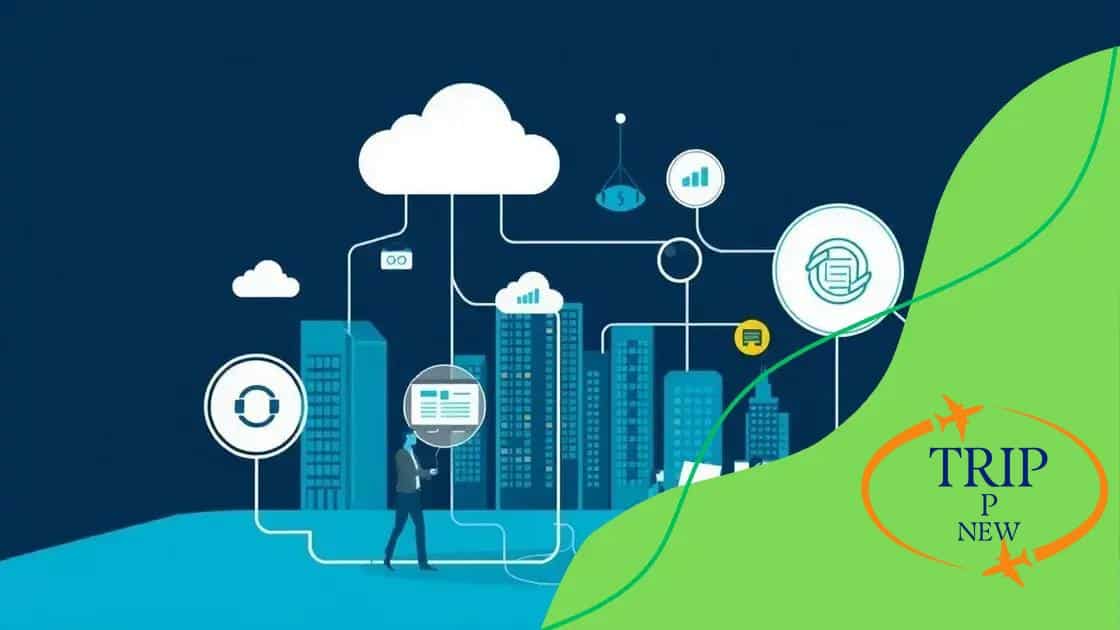Smart city data management challenges you need to know

Anúncios
Smart city data management challenges include data integration, security, and public engagement, with future trends focusing on technologies like IoT, AI, and blockchain to enhance urban living and sustainability.
Smart city data management challenges are critical to urban planning and sustainability. As cities grow, handling data efficiently becomes essential. What obstacles do cities face, and how can they be tackled to improve life for residents?
Anúncios
Understanding data management in smart cities
In today’s modern world, data management plays a vital role in the development of smart cities. Cities are becoming more connected, using data to improve infrastructure and enhance the quality of life for their residents. To truly understand this, we need to explore what data management involves in a smart city context.
Data collection is the first step in managing information effectively. Smart cities gather data from various sources, including sensors, cameras, and community feedback. This information is essential for making informed decisions about city planning and resource allocation.
Key components of smart city data management
A few critical elements make up the foundation of effective data management:
Anúncios
- Data integration: Different systems need to communicate seamlessly. By integrating data from various sources, cities can obtain a clearer picture of their operations.
- Data security: Protecting sensitive information is crucial. As cities collect vast amounts of data, ensuring its safety against cyber threats is paramount.
- Data analysis: Once data is collected, it must be analyzed to derive insights. Advanced tools and technologies help city planners understand trends and make better decisions.
- Public engagement: Involving citizens in the data collection process can improve transparency and trust. Communities can provide valuable feedback that shapes city policies.
Moreover, the challenge of managing data efficiently often revolves around the volume and variety of data. With so much information flowing in, cities must have robust systems in place to store and process this data. Real-time data analytics can help cities respond quickly to issues, from traffic management to emergency services.
Furthermore, a significant aspect of data management involves ensuring accessibility. Making data open to the public fosters a collaborative atmosphere where residents can actively participate in the civic process. This openness can lead to innovative solutions to urban challenges.
In conclusion, understanding data management in smart cities is critical for their growth and efficiency. By focusing on key components like data integration, security, and public engagement, cities can utilize data to create environments that are not only smarter but also more livable for everyone.
Common challenges in managing smart city data
Managing data in smart cities can present numerous hurdles. These common challenges impact how effectively cities can utilize their data for decision-making and operations. Addressing these obstacles is crucial for creating effective urban environments.
One of the primary issues is the integration of diverse data sources. Smart cities collect information from various devices and systems, including traffic sensors, weather stations, and public transportation. Ensuring that all this data works together seamlessly is often complex.
Data quality and accuracy
Another challenge lies in maintaining data quality. Inaccurate or incomplete data can lead to poor decision-making. Therefore, cities must invest in systems that regularly check and clean data to ensure its reliability.
- Data validation: Implementing processes to check data consistency.
- Regular updates: Ensuring data is current and relevant.
- User feedback: Leveraging community insights to identify and correct inaccuracies.
Moreover, data security has become a pressing concern. With the increase in data breaches and cyber threats, protecting sensitive information is vital. Cities need to adopt robust security measures to safeguard data against unauthorized access.
Furthermore, the challenge of public engagement can hinder effective data management. Citizens often feel disconnected from how their data is used. Transparency is essential for building trust, and cities should involve residents in discussions about data collection and usage.
Lastly, adapting to rapid technological changes can be overwhelming. New tools and platforms emerge continually, making it hard for cities to keep pace. Training staff and ensuring that technology is integrated effectively is crucial in overcoming this barrier.
Strategies for effective data integration

Effective data integration is crucial for the success of smart cities. By combining data from various sources, cities can gain valuable insights and enhance decision-making processes. Here are some strategies for effective data integration that can help cities leverage their data better.
First, establishing a standardized data framework is essential. This ensures that data from different sources can be easily merged and understood. By having common formats and protocols, cities can avoid compatibility issues that arise from disparate systems.
Utilizing APIs for seamless integration
Another effective strategy is to use Application Programming Interfaces (APIs). APIs allow different software applications to communicate and share data effortlessly. By implementing APIs, cities can facilitate real-time data sharing between departments. This can streamline operations in areas like traffic management and public safety.
- Real-time updates: APIs enable immediate data updates, ensuring decisions are based on the latest information.
- Interdepartmental collaboration: Departments can easily access each other’s data, leading to more coordinated efforts.
- Scalability: As cities grow, APIs can help integrate new data sources without major overhauls.
Moreover, investing in cloud-based solutions can also enhance data integration. Cloud platforms can store large volumes of data, making it accessible from anywhere. This approach promotes collaboration among city planners, allowing them to work together on shared data without geographic limitations.
Training staff to use integrated data systems is an important aspect too. Offering training programs that focus on the importance of data integration can empower employees to leverage data more effectively. When staff understand the value of integrated data, they are more likely to utilize it in their daily tasks.
Lastly, engaging with the community can provide additional insights for data integration efforts. Involving the public in the data-sharing process not only fosters transparency but encourages feedback that can help refine integration strategies. Ensuring that residents understand how their data is used builds trust and enhances participation.
The role of technology in smart city data management
Technology plays a pivotal role in managing data within smart cities. It helps collect, process, and analyze vital information that improves urban living. Understanding how technology influences data management is crucial for cities aiming to become smarter and more efficient.
One of the key technologies in data management is the Internet of Things (IoT). IoT devices, such as sensors and cameras, gather real-time data from various sources, including traffic patterns, weather conditions, and energy consumption. This influx of data facilitates informed decision-making, allowing cities to respond swiftly to changing conditions.
Data analytics platforms
Another important aspect is the use of data analytics platforms that help cities interpret vast amounts of information. These platforms process the data collected from IoT devices, enabling city planners to identify trends and predict future needs. By leveraging analytics, municipalities can allocate resources more effectively and improve service delivery.
- Predictive analytics: Anticipate potential issues before they arise, such as traffic congestion or resource shortages.
- Real-time reporting: Monitor city operations continuously, ensuring quick response to incidents.
- Visualization tools: Present data in user-friendly formats, making it easier for decision-makers to understand complex information.
Moreover, cloud computing is transforming how cities store and manage data. By utilizing cloud services, cities can access data from anywhere, ensuring that information is readily available to stakeholders and the public. This enhances collaboration among departments and promotes transparency.
Integrating artificial intelligence (AI) into data management processes can further enhance efficiency. AI algorithms can analyze data patterns and automate routine tasks, allowing city staff to focus on more strategic initiatives. For instance, AI can help optimize traffic signals based on real-time traffic data, improving flow and reducing congestion.
In addition, mobile applications empower residents to engage with their city’s data. When citizens have access to real-time information, such as public transportation schedules or road closures, they can make better decisions about their daily activities. This increased involvement fosters a sense of community and enhances overall satisfaction with urban living.
Future trends in smart city data solutions
Future trends in smart city data solutions are shaping the way urban areas will function. As cities evolve, staying updated with technological advancements is critical for improving lives and enhancing sustainability. Understanding these trends can help city officials and planners make informed decisions.
One significant trend is the rise of edge computing. By processing data closer to where it is generated, cities can achieve faster response times. This reduces latency and allows real-time decision-making, essential for traffic management and emergency response systems.
Increased use of artificial intelligence
Another important trend is the increased use of artificial intelligence (AI) and machine learning. These technologies can analyze vast amounts of data to identify patterns and predict future events. For instance, AI can optimize energy usage by predicting demand, helping to reduce waste and costs.
- Smart lighting systems: AI can adjust street lighting based on pedestrian activity, saving energy and enhancing safety.
- Predictive maintenance: Using AI to monitor infrastructure can help predict when repairs are needed, preventing costly breakdowns.
- Enhanced public safety: AI algorithms can analyze data from cameras and sensors to improve emergency response times.
Blockchain technology is also emerging as a significant player in smart city data solutions. Its ability to provide secure and transparent data transactions enhances trust among residents and city officials. For example, blockchain can secure data sharing between city departments while ensuring citizen privacy.
Moreover, the emphasis on open data initiatives is growing. Cities are increasingly making their data available to the public to foster innovation. By enabling citizens and developers to access municipal data, cities can encourage the creation of new applications and services that address local challenges.
Finally, sustainability and resilience are becoming central themes in data solutions. Future trends will focus on using data to improve environmental outcomes, such as reducing carbon footprints and managing natural resources effectively. Smart city data solutions will play a crucial role in meeting climate goals while ensuring quality of life for residents.
FAQ – Frequently Asked Questions about Smart City Data Management
What is the role of IoT in smart city data management?
IoT devices gather real-time data from various sources, enhancing decision-making in areas like traffic control and resource allocation.
How does AI improve smart city data solutions?
AI analyzes large data sets to identify patterns, optimize resources, and predict future trends, making urban management more efficient.
What are open data initiatives?
Open data initiatives make city data accessible to the public, promoting innovation and allowing residents to participate in urban planning.
How can cities ensure data security?
Cities can adopt blockchain technology and robust cybersecurity measures to protect sensitive data and ensure secure transactions.





